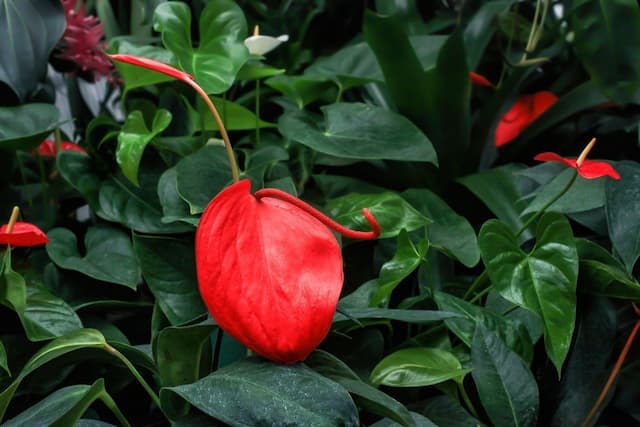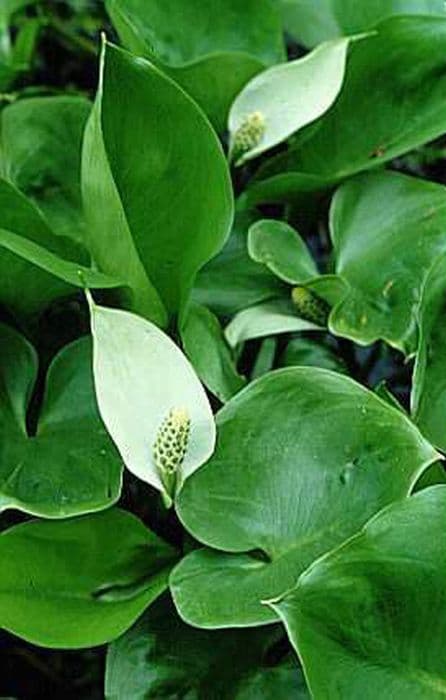Calla Lily 'Captain Morelli' Zantedeschia 'Captain Morelli' (PBR) (Captain Series)

ABOUT
The Zantedeschia 'Captain Morelli' (PBR), commonly known as the Calla Lily from the Captain Series, is renowned for its striking appearance. This cultivar displays a distinctive flower shape that is characteristic of Calla Lilies: a large, fluted spathes that wrap around the protruding spadix. The spathes of 'Captain Morelli' have an alluring color, a deep and rich hue that can range from burgundy to a near chocolaty shade, creating a velvety appearance that is visually captivating. The leaves of 'Captain Morelli' present a lush green background, with most varieties of Calla Lilies featuring arrow-shaped foliage. In this cultivar, the leaves may also exhibit white or lighter colored speckles or spots, which add to its ornamental appeal. As for the stems, they are sturdy and upright, providing a robust support for the elegant blooms. This allows the plant to showcase its flowers prominently, making them standout brilliantly when the plant is in full bloom. The overall aesthetic of 'Captain Morelli' is one of sophistication and elegance, with a striking color palette that can add a touch of drama to any garden setting or serve as a focal point in floral arrangements.
About this plant
 Names
NamesFamily
Aracaea
Synonyms
Calla Lily, Arum Lily, Captain Morelli Calla Lily.
Common names
Zantedeschia 'Captain Morelli'
 Toxicity
ToxicityTo humans
Calla Lily (Zantedeschia 'Captain Morelli') contains calcium oxalate crystals, which are toxic to humans. If ingested, the crystals can cause a burning sensation in the mouth, lips, and tongue, as well as difficulty swallowing, vomiting, and diarrhea. In severe cases, ingestion can lead to difficulty breathing and may require medical attention.
To pets
Calla Lily (Zantedeschia 'Captain Morelli') is toxic to pets due to the presence of calcium oxalate crystals. If a pet ingests any part of the plant, they may experience symptoms such as oral irritation, drooling, pawing at the face, decreased appetite, and vomiting. In severe cases, it can lead to difficulty breathing and swelling of the airways, which requires immediate veterinary care.
 Characteristics
CharacteristicsLife cycle
Perennials
Foliage type
Deciduous
Color of leaves
Varied
Flower color
Orange
Height
1-2 feet (30-60 cm)
Spread
1-2 feet (30-60 cm)
Plant type
Herb
Hardiness zones
8
Native area
South Africa
Benefits
 General Benefits
General Benefits- Attractive Flowers: Zantedeschia 'Captain Morelli' produces striking, deep-orange to terracotta-colored spathes that add a vibrant pop of color to any garden or floral arrangement.
- Long Blooming Period: This cultivar typically has a lengthy flowering period that extends throughout spring and summer, providing long-lasting visual interest.
- Low Maintenance: As a hardy plant, it requires minimal care once established, making it ideal for gardeners of all skill levels.
- Drought Tolerance: Once established, it is quite tolerant of dry conditions, reducing the need for frequent watering.
- Versatile Use: Suitable for planting in beds, borders, and containers, this Calla Lily is versatile and can fit into various garden designs and spaces.
- Attracts Wildlife: The vibrant flowers can attract pollinators like bees and butterflies, promoting biodiversity in the garden.
- Compact Size: Being part of the Captain Series, it is a compact hybrid, making it suitable for small gardens or spaces where larger plants would be impractical.
 Medical Properties
Medical PropertiesThis plant is not used for medical purposes.
 Air-purifying Qualities
Air-purifying QualitiesThis plant is not specifically known for air purifying qualities.
 Other Uses
Other Uses- Photography prop: The striking flowers of Calla Lilies make them ideal subjects for both professional and amateur photographers looking to capture their elegance and vibrant color.
- Art inspiration: Calla Lilies are often used by artists as a muse in paintings and drawings due to their unique shape and beauty.
- Eco-friendly funerals: Biodegradable Calla Lily flower arrangements are becoming more popular for green burials.
- Fashion design: The shape and lines of Calla Lilies can inspire fashion designers in creating flowing, organic garments and accessories.
- Crafting: Dried Calla Lily flowers can be used in crafting, such as in making bookmarks, greeting cards, or pressed flower art.
- Vegetable dye: The pigments from Calla Lily petals may be used to create natural dyes for fabric or paper.
- Culinary presentation: While not edible, Calla Lily blooms can be used as an elegant garnish for plating high-end culinary dishes in restaurants.
- Perfumery: The subtle fragrance of Calla Lilies may be used as inspiration for creating perfumes and scented oils, although it's more for the scent's idea rather than actual extraction.
- Theme parties: Calla Lilies are great for decorating thematic events or parties, such as 1920s-inspired gatherings where their style fits the art deco aesthetic.
- Education: Calla Lilies can be used in classrooms to teach about plant anatomy, pollination, and the life cycle of flowers.
Interesting Facts
 Feng Shui
Feng ShuiThe Calla Lily is not used in Feng Shui practice.
 Zodiac Sign Compitability
Zodiac Sign CompitabilityThe Calla Lily is not used in astrology practice.
 Plant Symbolism
Plant Symbolism- Beauty: Calla lilies are often considered a symbol of beauty due to their elegant and versatile appearance.
- Purity: The sleek and pure look of the calla lily flower is commonly associated with purity and innocence.
- Rebirth: With their trumpet-shaped blossoms, calla lilies are thought to represent resurrection and new beginnings, often used in Easter services.
- Transcendence: The calla lily's ability to bloom both in water and on land signifies transcendence and overcoming difficult circumstances.
- Eternal love: Due to its perennial nature, the calla lily is seen as a symbol of unwavering and everlasting love.
- Femininity: The soft curves of the calla lily have been equated with feminine beauty and grace.
- Marriage: Calla lilies are a popular choice in wedding bouquets and decorations, signifying marital bliss and devotion.
 Water
WaterCalla lilies, like the Zantedeschia 'Captain Morelli', prefer to be kept moist but not waterlogged. During active growth, water the plant enough to soak the soil and then allow the top inch to dry out before watering again. Typically, this would mean watering the plant once every week with about a quarter to a half gallon of water, depending on the size of the pot and the environmental conditions. Reduce watering frequency when the plant is dormant, usually in the fall and winter months, to prevent bulb rot.
 Light
LightCalla lilies, such as Zantedeschia 'Captain Morelli', thrive in bright, indirect sunlight. A spot near a window that receives morning light or filtered afternoon sun would be ideal to promote healthy growth without the risk of leaf burn. Avoid placing the plant in direct midday sun, especially during the hot summer months, as this can damage the foliage and blooms.
 Temperature
TemperatureCalla lilies, including the Zantedeschia 'Captain Morelli', do best in temperatures ranging from 60 to 75 degrees Fahrenheit. They can tolerate a minimum temperature of around 50 degrees Fahrenheit but should be protected from frost. Avoid exposing the plant to temperatures over 80 degrees Fahrenheit for extended periods as it can cause stress.
 Pruning
PruningZantedeschia 'Captain Morelli', commonly known as calla lily, should be pruned to remove spent flowers and yellowed leaves to promote health and vigor. This can be done as needed throughout the growing season. The best time for more extensive pruning, such as cutting back the foliage, is after the leaves have died back in the fall, signaling the plant is entering dormancy.
 Cleaning
CleaningAs needed
 Soil
SoilCaptain Morelli calla lily thrives in rich, well-draining soil with a slightly acidic to neutral pH of 5.5 to 7.0. A mix of two parts peat moss or coco coir, one part perlite, and one part garden soil or potting mix would create an ideal environment for healthy growth.
 Repotting
RepottingCaptain Morelli calla lilies should be repotted every two to three years or when the container becomes crowded. This will give the plant room to grow and ensure it has access to fresh nutrients from new soil.
 Humidity & Misting
Humidity & MistingCaptain Morelli calla lilies prefer high humidity levels, around 60-70%. Maintaining this humidity will support their lush growth and vibrant blooms.
 Suitable locations
Suitable locationsIndoor
Place Calla Lily in bright, indirect light, keep soil moist.
Outdoor
Plant Calla Lily in partial shade, protect from intense afternoon sun.
Hardiness zone
8-10 USDA
 Life cycle
Life cycleZantedeschia 'Captain Morelli', commonly known as Calla Lily, begins its life cycle as a rhizome, a type of underground stem. The plant enters a period of dormancy, typically in the winter, where it ceases growth to conserve energy. As the temperatures warm up in spring, the rhizome sprouts and the plant begins to grow, producing sturdy stems and arrow-shaped leaves. Following the foliage development, it flowers, generally in late spring to early summer, with the trademark spathe and spadix structure that characterizes calla lilies. After pollination, which is often aided by insects, the plant produces berries containing seeds that can be dispersed to form new plants. The above-ground parts of the plant will eventually die back after the growing season, returning the plant to a period of dormancy, ready to start the cycle anew in the next growing season.
 Propogation
PropogationPropogation time
Spring-Early Summer
Zantedeschia 'Captain Morelli', commonly known as Captain Morelli calla lily, is typically propagated via division, which is the most popular and straightforward method for this plant. During the late winter or spring, as the plant emerges from dormancy, divide the rhizomes, ensuring that each section has at least one growth point or "eye". Carefully separate the rhizomes using a clean, sharp knife to minimize damage, and replant them immediately. The divided sections should be planted at a depth of about 3 inches (approximately 7.5 centimeters) in well-draining soil with the eyes facing upward. Water the newly planted rhizomes gently to settle the soil and initiate growth. This process encourages the development of strong, new plants that will bloom in the following season.









